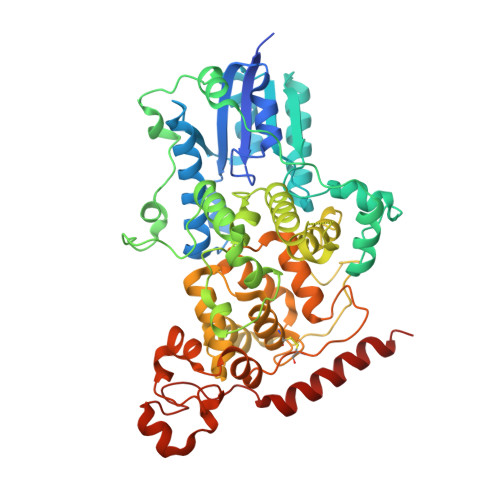CRY2 isoform selectivity of a circadian clock modulator with antiglioblastoma efficacy.
Miller, S., Kesherwani, M., Chan, P., Nagai, Y., Yagi, M., Cope, J., Tama, F., Kay, S.A., Hirota, T.(2022) Proc Natl Acad Sci U S A 119: e2203936119-e2203936119
- PubMed: 36161947
- DOI: https://doi.org/10.1073/pnas.2203936119
- Primary Citation of Related Structures:
7V8Y, 7V8Z - PubMed Abstract:
The mammalian cryptochrome isoforms, CRY1 and CRY2, are core circadian clock regulators that work redundantly. Recent studies revealed distinct roles of these closely related homologs in clock output pathways. Isoform-selective control of CRY1 and CRY2 is critical for further understanding their redundant and distinct roles. KL001 was the first identified small-molecule CRY modulator that activates both CRY1 and CRY2. SHP656 is an orally available KL001 derivative and has shown efficacy in blood glucose control and inhibition of glioblastoma stem cell (GSC) growth in animal models. However, CRY isoform selectivity of SHP656 was uncharacterized, limiting understanding of the roles of CRY1 and CRY2. Here, we report the elucidation of CRY2 selectivity of SHP656. SHP656 lengthened cellular circadian period in a CRY2-dependent manner and selectively interacted with CRY2. By determining the X-ray crystal structure of CRY2 in complex with SHP656 and performing molecular dynamics simulations, we elucidated compound interaction mechanisms. SHP656 binding was compatible with the intrinsic CRY2 gatekeeper W417 "in" orientation and also a close "further in" conformation. Perturbation of W417 interaction with the lid loop resulted in a reduced effect of SHP656 on CRY2, supporting an important role of gatekeeper orientation in isoform selectivity. We also identified the R form of SHP656 (called SHP1703) as the active isomer. Treatment with SHP1703 effectively reduced GSC viability. Our results suggest a direct role of CRY2 in glioblastoma antitumorigenesis and provide a rationale for the selective modulation of CRY isoforms in the therapeutic treatment of glioblastoma and other circadian clock-related diseases.
- Institute of Transformative Bio-Molecules, Nagoya University, Nagoya 464-8601, Japan.
Organizational Affiliation:

















